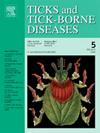Limited evidence of infection with other tick-borne pathogens in patients tested for Lyme neuroborreliosis in the Netherlands
IF 3.4
2区 医学
Q2 INFECTIOUS DISEASES
引用次数: 0
Abstract
Ixodes ricinus is the main vector of the causative agents of Lyme neuroborreliosis. This tick species can also transmit tick-borne encephalitis virus (TBEV), spotted fever group (SFG) Rickettsia and Borrelia miyamotoi to humans. These tick-borne pathogens are present in Dutch ticks and have also been associated with human neurological infections, but well characterized disease cases are seldom reported. We therefore assessed the evidence for TBEV, SFG Rickettsia or B. miyamotoi infection in clinically well-described patients suspected of Lyme neuroborreliosis.
We retrospectively included patients with specific predefined clinical criteria from patients that were tested for Lyme neuroborreliosis between 2010 and 2014 at an academic Lyme borreliosis Center. Serology was performed on available serum samples, and cerebrospinal fluid (CSF) was tested by molecular methods.
Out of 514 potentially eligible patients, 176 individual patients were included. None of CSF samples was positive for the tested tick-borne pathogens, except for one previously described patient with Borrelia miyamotoi disease (BMD). Serology revealed 27, 14 and three patients with antibodies against SFG Rickettsia, B. miyamotoi and TBEV, respectively. No distinctive clinical symptoms or signs could be associated with seropositivity against any of these tick-borne pathogens.
Apart from the previously published BMD case, we were unable to find convincing evidence of new cases of tick-borne encephalitis, spotted fever rickettsiosis or BMD in a cohort of patients suspected of Lyme neuroborreliosis. While antibodies against these tick-borne pathogens were detected, we could not associate these findings to clinical symptoms or signs. Therefore, prospective studies on humans with tick exposure are necessary to describe the prevalence, etiology and clinical symptoms of these tick-borne diseases other than Lyme borreliosis and tick-borne encephalitis.
荷兰莱姆神经源性疾病患者感染其他蜱媒病原体的证据有限。
莱姆蓖麻蜱是莱姆神经性包虫病病原体的主要传播媒介。这种蜱虫还能将蜱传脑炎病毒(TBEV)、斑疹热群立克次体(SFG)和宫本氏鲍氏杆菌传播给人类。这些蜱传病原体存在于荷兰蜱中,也与人类神经系统感染有关,但很少有特征明确的疾病病例报道。因此,我们评估了临床描述良好的莱姆神经性包虫病疑似患者感染 TBEV、SFG 立克次体或 B. miyamotoi 的证据。我们回顾性地纳入了 2010 年至 2014 年间在莱姆病学术中心接受莱姆神经性包虫病检测的患者中符合特定预定临床标准的患者。我们对现有血清样本进行了血清学检测,并通过分子方法对脑脊液(CSF)进行了检测。在 514 名可能符合条件的患者中,有 176 名患者被纳入研究。除了一名之前描述过的宫本鲍曼不动杆菌病(BMD)患者外,其他患者的脑脊液样本均未对所检测的蜱传病原体呈阳性反应。血清学检查显示,分别有 27 名、14 名和 3 名患者体内含有针对 SFG 立克次体、宫本氏鲍雷和 TBEV 的抗体。这些蜱传病原体的血清阳性反应均未出现明显的临床症状或体征。除了之前公布的BMD病例外,我们无法在怀疑患有莱姆神经源性疾病的患者群中找到蜱传脑炎、斑热立克次体病或BMD新病例的令人信服的证据。虽然检测到了针对这些蜱传病原体的抗体,但我们无法将这些结果与临床症状或体征联系起来。因此,有必要对接触过蜱虫的人类进行前瞻性研究,以描述除莱姆包虫病和蜱传脑炎以外的这些蜱传疾病的发病率、病因和临床症状。
本文章由计算机程序翻译,如有差异,请以英文原文为准。
求助全文
约1分钟内获得全文
求助全文
来源期刊

Ticks and Tick-borne Diseases
INFECTIOUS DISEASES-MICROBIOLOGY
CiteScore
6.90
自引率
12.50%
发文量
185
审稿时长
6-12 weeks
期刊介绍:
Ticks and Tick-borne Diseases is an international, peer-reviewed scientific journal. It publishes original research papers, short communications, state-of-the-art mini-reviews, letters to the editor, clinical-case studies, announcements of pertinent international meetings, and editorials.
The journal covers a broad spectrum and brings together various disciplines, for example, zoology, microbiology, molecular biology, genetics, mathematical modelling, veterinary and human medicine. Multidisciplinary approaches and the use of conventional and novel methods/methodologies (in the field and in the laboratory) are crucial for deeper understanding of the natural processes and human behaviour/activities that result in human or animal diseases and in economic effects of ticks and tick-borne pathogens. Such understanding is essential for management of tick populations and tick-borne diseases in an effective and environmentally acceptable manner.
 求助内容:
求助内容: 应助结果提醒方式:
应助结果提醒方式:


